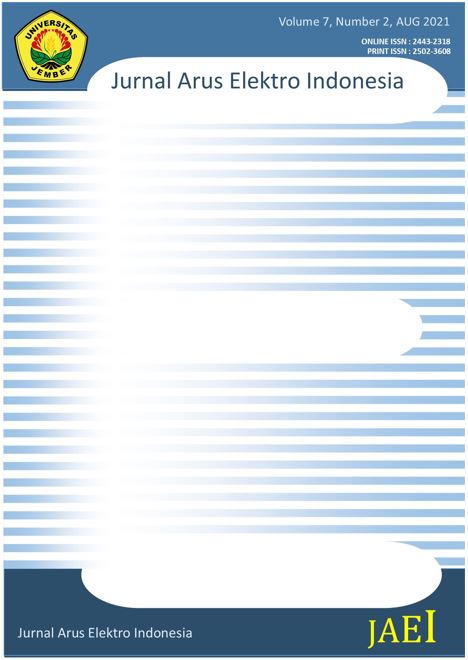Rancang Bangun Komunikasi Sistem Isyarat Bahasa Indonesia (SIBI) Bagi Anak Tunarungu/Wicara berbasis Speech Recognition
DOI:
https://doi.org/10.19184/jaei.v7i2.23614Abstract
Abstrak
Komunikasi menjadi hal terpenting dan utama bagi kehidupanmmanusia dan tidak semua orang dapat menggunakan indra pendengarannya dengan sempurna. Penyembuhan terhadap indra pendengaran bukan solusi yang efektif. Dikarenakan terdapat dua faktor yang mempengaruhinya yaitu (1) faktor keturunan dan biaya yang dikeluarkan sangat mahal. Bahasa isyarat menjadi media komunikasi yang digunakan oleh anak tunarungu/wicara untuk meminimalisir keterbatasan yang mereka miliki berupa keterbatasan pengucapan dan pendengaran. SIBI (Sistem Isyarat Bahasa Indonesia) merupakan bahasa isyarat yang baku sehingga memudahkan untuk berkomunikasi. Akan tetapi fakta dilapangan menunjukkan bahwa tidak semua dapat mengerti dan menggunakan bahasa isyarat. Sistem komunikasi yang berbasis speech recognition menjadi media komunikasi yang tepat. Sistem ini dapat memudahkan berkomunikasi antara anak tunarungu/wicara dengan anak normal yang harapannya tidak ada lagi perbedaan atau diskriminasi terhadap anak berkebutuhan khusus. Pada penelitian ini kami menggunakan sistem pengenalan suara dan Model Hidden Markov (HMM). Cara kerja sistem ini yakni menggunakan input suara kemudian diproses oleh PC/Laptop. Adapun outputnya berupa teks kalimat dan video isyarat hasil terjemah dari input suara yang diberikan. Sofware yang kami gunakan ialah python 3.6.5 dan Qt-Designer sebagai interfacenya. Hasil penelitian menunjukkan tingkat akurasi yang dihasilkan sangat baik, sedangkan apabila terjadi noise disekitar maka tingkat akurasi menjadi sedikit berkurang yakni 85%. Dengan demikian penelitian memiliki nilai manfaat dan kontribusi kepada anak tunarungu/wicara. Media ini memudahkan siswa agar dapat berkomunikasi dengan anak normal pada umumnya.
Kata Kunci — Komunikasi, SIBI, Speech Recognition, Hidden Markov Model.
Abstract
Communication is the most important and foremost thing in human life, but not everyone can use their sense of hearing perfectly. The healing of sense of hearing is not an effective solution, because there are two factors that influence it, namely (1) heredity and (2) the very expensive cost. Sign language is a communication medium used by deaf/mute children to minimize the limitations they have in the form of speech and hearing limitations. Sibi (Indonesian sign system) is a standard sign language that makes communication easier. However, the facts in the field show that not all normal children can understand and use sign language. So that, a communication system based on speech recognition is made. This system can make the communication between deaf/mute children and normal children becomes easier and it is expected that there will be no more differences or discrimination against children with special needs. In this study, we used a speech recognition system and the hidden markov model (HMM). The way this system works is using voice input which is then processed by a PC/laptop. The output is in the form of sentence text and sign video translated from the given voice input. The sofware we use is python 3.6.5 and Qt-Designer as the interface. The results of the study show a very good level of accuracy, while if there was noise around, the accuracy rate would be 85%. Thus, this study has the value of benefits and contributions to deaf/mute children to be able to communicate with normal children in general.
Keywords — Communication, SIBI, Speech recognition, Hidden Markov Model.
Downloads
Additional Files
Published
Issue
Section
License
Sebagai penulis yang sesuai naskah dan atau atas nama semua penulis, saya menjamin bahwa :
- Naskah yang diajukan adalah karya asli saya/kami sendiri.
- Naskah belum dipublikasikan dan tidak sedang diajukan atau dipertimbangkan untuk diterbitkan di tempat lain.
- Teks, ilustrasi, dan bahan lain yang termasuk dalam naskah tidak melanggar hak cipta yang ada atau hak-hak lainnya dari siapa pun.
- Sebagai penulis yang sesuai, saya juga menjamin bahwa "JAEI Editor Journal" tidak akan bertanggung jawab terhadap semua klaim hak cipta dari pihak ketiga atau tuntutan hukum yang dapat diajukan di masa depan, dan bahwa saya akan menjadi satu-satunya orang yang akan bertanggung jawab dalam kasus tersebut.
- Saya juga menjamin bahwa artikel tersebut tidak mengandung pernyataan memfitnah atau melanggar hukum.
- Saya/kami tidak menggunakan metode yang melanggar hukum atau materi selama penelitian.
- Saya/kami memperoleh semua izin hukum yang berkaitan dengan penelitian,
- Saya/kami berpegang pada prinsip-prinsip etika selama penelitian.
- Saya/kami bersedia apabila artikel kami dipublikasikan oleh tim redaksi JAEI



